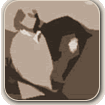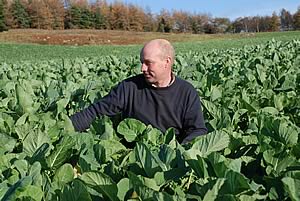 |
|||||||||
|
|||||||||||||||||||
|
|
Outwintering
on Brassicas In order secure a future for the 70-cow beef suckler enterprise that he runs alongside 500 breeding ewes at 115ha (285acre) West Highwood, near Barnard Castle, Tony Wilson knows he must reduce costs and, if possible, manage with less labour.
Tony is among a growing number of north farmers who realise that out-wintering using a brassica based system is one possible solution, and an initial experiment with 20 spring calving dry cows on a small area of kale in 2006 started to show what could be achieved. As a result, Tony, a tenant of the Raby Estates, has extended his brassica area for 2007 and adapted his approach, and has now set his sights on keeping all his cows outdoors all year round. “The ultimate aim must be to avoid the need to house the cows at all,” he said. “We estimate that it costs between £5.50 and £6.00 per cow per week to feed the herd inside, and then there is the added cost of bedding straw and of carting and spreading muck. “The cost of growing a crop of kale that will feed the cows for 120 days is just a fraction of this, and – even with moving the feed fence every day – I believe the out-wintering system requires less labour overall.” Most of the Limousin x Belgian Blue cows calve in May and June, to a Blonde bull, and calves are weaned at the end of November and come inside. Bulls are kept entire and are reared to finish at around 650kg liveweight at 17-18 months, and heifers are finished at 21-23 months. The aim is to bring calving forward to around April, calving all cattle outside, therefore allowing the calves longer on the cows before weaning. All the dry cows would then be out-wintered on an area of 16–18 acres of kale. For this year, the kale area is just over 8 acres, which Tony estimates to be sufficient for 30 cows for 120 days. He’s switched from a taller variety to the semi-dwarf Maris Kestrel, for the superior leaf size and leaf-to-stem ratio, and expects this to be easier to strip graze. The field is sloping and relatively free-draining, with it being strip grazed from the top down. A grass run-back area has been left at the top and straw bales will be placed in the crop in advance to provide the required source of fibre that will complement the highly digestible kale. The crop was drilled in June following first cut silage and will be followed by a spring-drilled crop of triticale and lupins grown for wholecrop silage (to winter-feed growing cattle). This will in turn be followed by a fast growing brassica crop (the rape/kale hybrid Swift), which is being grazed by breeding ewes in December and January and followed by a spring grass and clover reseed. Helen Mathieu of British Seed Houses, said: “We estimate kale grown under a full cultivation regime with the required level of fertiliser and agrochemicals to work out at around £1.30/cow/week. “This means that Tony’s 3ha area will save him around £4 per cow per week over the winter, in feed costs alone, even with an allowance for the straw fed alongside the kale, and he’s expecting reduced labour and healthier cows as well.”
Father and son Brendan and Brian Atkinson have taken a serious strategic look at their beef production system since decoupling and they are using a combination of out-wintering and conversion to Stabilisers to keep their suckler production viable. Having at one stage kept as many as 500 suckler cows at 600 acre Scratchmere Scar, near Penrith, they have reduced numbers to 300 and will continue to down-scale to a target of 200 cows. In conjunction with this, the aims are to virtually eliminate all concentrate feeding - even in the finishing of all home-reared cattle – and reduce the overall cost by keeping the cows outdoors all year round adopting a brassica based system. Scratchmere Scar has a good range of buildings, having been run as a dairy farm until 1997, and also has the potential to grow a lot of forage, either as grass, wholecrop, or brassica fodder crops. “We have slatted accommodation for 1,000 cattle, so we will continue to buy in weaned calves and rear them on a total mixed ration system,” said Brian. “The aim with the sucklers is to use our rough pasture for grazing during the summer months, and supplement this with brassicas such as kale and other faster growing rape/kale hybrids during the winter months. We believe we can run a herd of 200 cows on this basis, without the need for them to come inside at any stage.” The spring-calving herd has been Limousin x Belgian Blue, but the introduction of Stabilisers as the Atkinsons believe the cattle are better suited to out-wintering and can be run successfully on a forage-only diet. “We are already seeing a reduction in our concentrates usage, and our aim is to grade up to a self-contained Stabiliser herd, breeding our own replacements and with the cows being kept outside all year round,” said Brian. Brassicas for out-wintering will fit into the farm’s rotation policy, alongside spring barley grown for wholecrop silage and grass reseeds. “We would drill kale in June following a first cut of silage, and/or a fast growing crop such as the rape/kale hybrid Swift after harvesting wholecrop at the end of July, so there is flexibility in the rotation and we are not relying on a single crop and a single sowing window,” added Brian. “The brassicas will typically be followed by a grass reseed in the spring, or could provide the platform for the spring cereal. “ For this year, a total of 10 ha (25 acres) of brassicas have been drilled at Scratchmere Scar, with a view to providing grazing for 70 cows for a period of 120 days. This is made up of a 4 ha (10 acre) field of Maris Kestrel kale and 6 ha (15 acres) of Swift. Supplemented with a fibre source of straw, this is estimated to be costing around 25 – 30p/cow/day, which is under half of the cost of feeding the cows were they to be housed and fed a conserved forage ration.
|
||||||||||||||||||

|
|
||||||||||||||||||
| home | agri-services | pedigree
pen | news | dairy | beef | machinery property | organisations | site map |
|||||||||||||||||||

Article by
Jennifer MacKenzie

